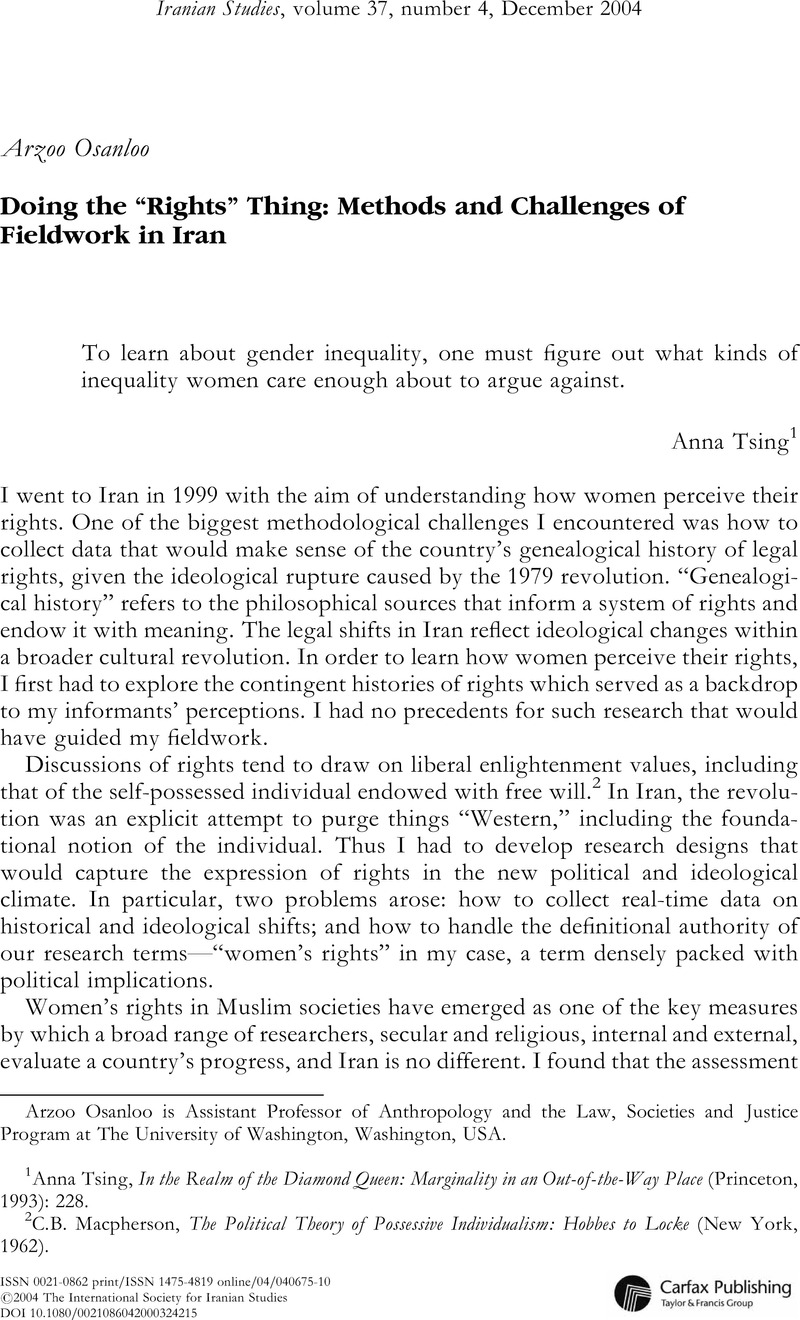Article contents
Doing the “Rights” Thing: Methods and Challenges of Fieldwork in Iran
Published online by Cambridge University Press: 01 January 2022
Abstract

- Type
- Articles
- Information
- Iranian Studies , Volume 37 , Issue 4: Special Issue: Ethnographic Fieldwork in Iran , December 2004 , pp. 675 - 684
- Copyright
- Copyright © 2004 The International Society for Iranian Studies
References
1 Tsing, Anna, In the Realm of the Diamond Queen: Marginality in an Out-of-the-Way Place (Princeton, 1993): 228Google Scholar
2 Macpherson, C.B., The Political Theory of Possessive Individualism: Hobbes to Locke (New York, 1962)Google Scholar.
3 Khomeini, R., Islam and Revolution, trans. Algar, H. (Berkeley, 1981): 441Google Scholar.
4 Mottahari's writings were published before the revolution. When Khomeini took charge, however, he sought to purge society of institutions that challenged or undermined this thinking. Motahhari, M., The System of Women's Rights in Islam (Qom, 1978)Google Scholar, cited in Paidar, P., Women and the Political Process in Twentieth-Century Iran (Cambridge, 1995)Google Scholar.
5 Paidar, Women and the Political Process.
6 As Haideh Moghissi has noted, some secular leftists shared in the beliefs that women and men had inherently different biological qualities and that women were better suited to domestic affairs. Moghissi, H., “Women in the Resistance Movement in Iran,” in Women in the Middle East: Perceptions, Realities and Struggles for Liberation, ed. Afshar, H. (New York, 1993): 162Google Scholar.
7 M. Taleghani, On Hejab (1979): 107, cited in Tabari, A. and Yeganeh, N., eds., In the Shadow of Islam: The Women's Movement in Iran (London, 1982)Google Scholar.
8 Azam Taleghani is the daughter of Ayatollah Taleghani, the prominent cleric who played an important role in the early years just after the revolution.
9 Iran Daily, April 29, 1999.
10 Iran Daily, April 29, 1999.
11 Iran Statistical Yearbook (Tehran, 1379/2001).
12 93 percent of my informants referred to themselves as middle-class or working class; 7 percent as poor or lower-class.
13 New York Times, December 7, 2001.
14 Los Angeles Times, June 5, 2001.
15 1.3 percent of my informants were between the ages of 80 and 89, 2.7 percent were between the ages of 70 and 79, 9.9 percent were between the ages of 60 and 69, 12.6 percent were between the ages of 50 and 59, 16.1 percent were between the ages of 40 and 49, 26.9 percent were between the ages of 30 and 39, 26.7 percent were between the ages of 20 and 29, and 5.8 percent were between the ages of 14 and 19. The youngest person I interviewed was fourteen years old.
16 Several government officials remarked that I was in a better position to explain women's rights in Iran to Americans than they were.
17 I distinguish “participant observation” from mere “observation” for two reasons. First, I was an engaged actor, a participant, in all the spaces where I was doing fieldwork, whether they were law offices or mourning rituals. Second, I recognize that an observer's intervention, even if by mere presence, affects the data.
18 For reasons of confidentiality, I refrain from mentioning names of ministries, NGOs and other offices where I conducted research.
19 The women who permitted me to interview them were similarly pre-disposed to speaking of their personal lives and beliefs.
20 Osanloo, A., “At the Juncture of Islam and Republic: Socio-legal constructions of women's rights in Iran” (Ph.D. dissertation, Stanford University, 2002)Google Scholar.
21 Mottahedeh, R., The Mantle of the Prophet: Religion and Politics in Iran (New York, 1985)Google Scholar.
- 3
- Cited by


